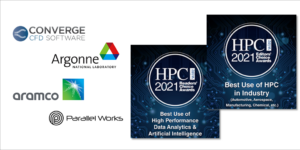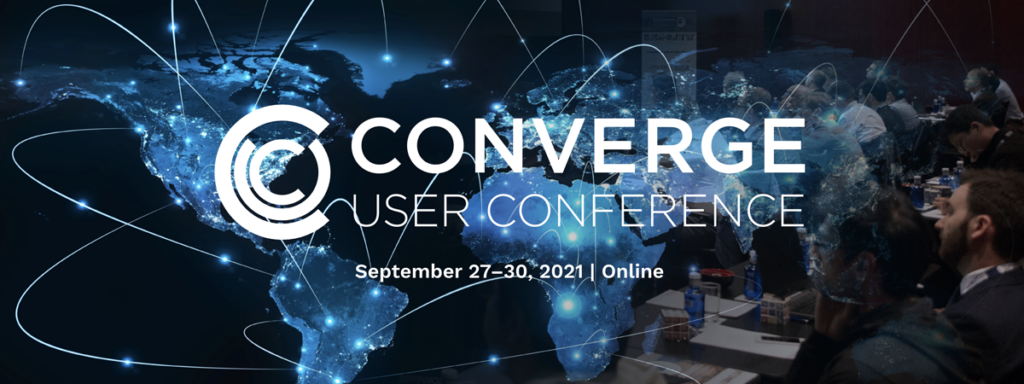
Author:
Kelly Senecal
Owner and Vice President of Convergent Science
2021 was a complicated year. The second full year of the pandemic offered reasons for hope and optimism, along with times of hardship and uncertainty. I sincerely hope that this next year is a turning point in the pandemic and that we see significant improvement around the world.
Despite the continuing pandemic, there have been exciting developments and opportunities for Convergent Science this past year. We are releasing CONVERGE 3.1, a major version of our software that includes many new features and enhancements. We strengthened relationships with our partners and collaborators, and forged new ones with universities around the world through our CONVERGE Academic Program. We were honored to receive several awards, and we have pushed further into new market segments and application areas. All the while, we have continued to strive to improve CONVERGE in a way that best meets your simulation needs and to provide our customers with the best possible support.

We’re pleased to be releasing a new major version of our software: CONVERGE 3.1. During development of this version, we focused on expanding CONVERGE’s physical modeling capabilities, improving user experience, and simplifying the workflow for advanced simulations. We added several new volume of fluid (VOF) modeling approaches for multi-phase flows that reduce numerical diffusion at fluid interfaces and enable you to simulate the separation of phases or immiscible liquids under the influence of gravity. CONVERGE 3.1 also offers implicit fluid-structure interaction (FSI) modeling, which increases the stability of the solver when simulating floating objects or simulating fluids and solids with similar densities. To complement this capability, CONVERGE 3.1 contains tools to generate realistic wind and wave fields. This set of features opens the door to many offshore and marine applications, such as floating offshore wind turbines and boat or ship hulls.
CONVERGE 3.1’s multi-stream simulation capability allows you to apply different solver settings and physical models to different regions of the domain. Using the multi-stream approach, you can model complex, multi-physics problems in a single simulation, which offers a simpler workflow than running multiple independent simulations. Another workflow enhancer in 3.1 is the ability to couple CONVERGE with ParaView Catalyst to perform in situ post-processing of your simulation results. You’ll find many other enhancements in CONVERGE 3.1, including moving inlaid meshes, the capability to simulate solid particles, and more flexibility for wall motion. We’re very excited about this new release, and we think it will greatly benefit users across many application areas.
At Convergent Science, we’re dedicated to creating innovative tools and methods that industry can leverage to accelerate the development of cutting-edge technology. We couldn’t achieve this goal without the invaluable collaborations we have with world-class institutions and companies. This year, several of our collaborative projects were recognized for their merit and contributions to the research community and society at large.
This summer, Convergent Science and Argonne National Laboratory were awarded funding through the U.S. Department of Energy’s 2021 Technology Commercialization Fund (TCF) to continue developing a deep learning framework called ChemNODE, which accelerates detailed chemistry CFD simulations for reacting flows. The goal of ChemNODE is to enable engineers to use detailed mechanisms that, compared to skeletal mechanisms, provide more predictive results for combustion simulations, without incurring such a large computational expense.
In the fall, Convergent Science received two 2021 HPCwire Awards.

With Aramco Research Center – Detroit and Argonne National Laboratory, we received the 2021 Editors’ Choice Award for Best Use of HPC in Industry. We were recognized for our work using high-performance computing and CONVERGE simulations to evaluate engine cold-start operations, during which the majority of emissions are formed in modern vehicles. We achieved a 26% improvement in combustion efficiency at cold conditions for a heavy-duty engine.
The second HPCwire Award we received was for a collaborative project with Argonne National Laboratory and Parallel Works. Together, we have been developing an automated machine learning-genetic algorithm (ML-GA) approach to accelerate design optimization and virtual prototyping. We coupled ML-GA with CONVERGE to perform a design optimization of a gasoline compression ignition engine and found that this approach sped up the process by ten times compared to the industry standard.
Another key way we are able to deliver top-notch products to our customers is through our partnerships. In 2021, we strengthened our partnership with Tecplot as we work to provide a seamless simulation workflow from pre- to post-processing. Tecplot for CONVERGE is included with a CONVERGE license, and now users have the convenient option to buy a full Tecplot 360 license directly from our Convergent Science sales team.
This year we also introduced GT-CONVERGE, a specialized version of CONVERGE that is fully integrated into GT-SUITE. GT-CONVERGE replaced our previous GT-SUITE product, CONVERGE Lite, and offers many more features and greater functionality, including conjugate heat transfer, a steady-state solver, automatic export of 3D visualization slices, enhanced wall models, and much more.

Another collaborative effort, the Computational Chemistry Consortium (C3) concluded Phase 1 of operations in 2021, culminating in the public release of C3MechV3.3. C3Mech is a new detailed kinetic model for surrogate fuels consisting of 3,761 species and 16,522 reactions. It contains chemistry for small species such as hydrogen, syngas, natural gas, and methanol; important surrogate fuel components for gasoline, diesel, and jet fuel; and NOx and PAHs. The mechanism represents the first time that the combustion community has developed and validated a mechanism combining small, intermediate, and large species in a self-consistent, comprehensive, and hierarchical way. C3Mech will help facilitate the study of low-carbon, carbon-neutral, and carbon-free fuels, which are going to play a critical role in the decarbonization of industry. If you’re interested in checking out the mechanism, it will soon be available to download on the C3 website.
At Convergent Science, we have always been strong believers in the importance of training the next generation of engineers, and we greatly value our relationships with universities and other academic institutions. Now, we have dedicated personnel to help cultivate these relationships. Our goal with the CONVERGE Academic Program is to make it easier for students around the world to access our software and to better support them throughout their academic journey.
This year, we also launched the CONVERGE Academic Competition, a simulation competition for students around the world. We’re challenging participants to design and execute a novel CONVERGE simulation that doesn’t just look nice, but also accurately captures the relevant physics of their system. We’re looking forward to seeing the creative simulations the competitors come up with, and we’re excited to showcase their work when the winners are announced next summer!

This year we held the first-ever global edition of our CONVERGE User Conference, with the goal of exposing attendees to research they might not otherwise come across. To accommodate attendees in different time zones, we hosted each of the four presentation sessions twice. In addition, we offered attendees the option to watch the presentations on-demand, and we also unveiled on-demand CONVERGE training. Each day of the conference, our support engineers hosted office hours so attendees could meet one-on-one with a CONVERGE expert to get answers to any questions they had. The event was a great success, with more than 400 attendees from six continents and nearly 30 countries. While we hope future user conferences can once again take place in person, we were thrilled to be able to host this virtual global event.
As I mentioned above, we introduced a new resource for CONVERGE users at our fall conference: on-demand training. Both introductory and advanced training courses are available on the Convergent Science Hub, and we’ll keep adding and updating courses as we go. We hope this convenient option helps you get up and running with CONVERGE on your own schedule—and our Support team is always available if you have questions. We’ll continue to offer live training throughout the year as well, virtually at the beginning of 2022 and hopefully (!) in person later in the year.
The primary mission of Convergent Science is twofold: (1) help current clients run the best CFD simulations possible, and (2) discover other industries that can benefit from CONVERGE’s unique combination of features. Our offices around the world are dedicated to fulfilling both parts of this mission.
In Europe, we’ve had a great year for bringing on new clients in a variety of industries, who plan to use CONVERGE for a broad array of applications: oil and gas, hydrogen injectors and engines, vacuum pumps, compressors and engines for refrigeration applications, fuel cells, marine technology, construction and agricultural engines, redesigning racing engines as motorsports move to renewable fuels, and more. We attended a wide variety of conferences, both virtually and in person, that covered topics ranging from tunnel safety to space propulsion to compressors. Our European team grew, and we expanded our office space to accommodate more growth in the future.
This year, our India branch celebrated its four-year anniversary. Our team in India continued to grow, gaining seven new employees in 2021. The team is busy exploring how to most effectively apply CONVERGE to applications such as motor cooling, battery thermal runaway, flexible fuel engines, pumps, and more. In addition, the India office is working to bridge the gap between industry and academia by helping students gain exposure to simulation software.
In the United States, our world headquarters in Madison, Wisconsin continued to thrive, with more than a dozen new hires this year. We’re continuing to branch out into exciting application areas including hydrogen, aerospace, batteries, biomedical applications, and renewable energy. With our dedicated university relations team, we strengthened our relationships with existing academic users and forged many new relationships as well. In 2021, we gained more than 180 new academic users in North and South America across 36 different labs and 14 universities.
Our partners at IDAJ continue to provide excellent support to CONVERGE users in China, Korea, and Japan. Major areas of focus for IDAJ include hydrogen engines and non-engine applications such as rotating machinery, battery burning, and spray painting. They hosted their popular IDAJ Conference Online 2021, which garnered over 2,800 attendees. In addition, we worked with IDAJ to port CONVERGE on Fugaku, the world’s fastest supercomputer. IDAJ demonstrated CONVERGE on Fugaku by running high-fidelity combustion simulations using large eddy simulations (LES) and detailed chemistry.
Despite the ongoing challenges of the pandemic, 2021 has been a successful year, and we’re looking forward to new opportunities in 2022. While virtual events have been a great way to connect during the pandemic, they just aren’t the same as seeing your colleagues face-to-face. We hope to be able to hold our next user conference in person and to attend more in-person tradeshows in the new year. We’re also looking forward to our next CONVERGE release—we have many great features under development, and we can’t wait to share them with you. We’re excited to continue to delve into new application areas and to strengthen our collaborations and partnerships. Above all, we look forward to helping you run novel simulations and providing you with the tools you need to create next-generation technology.


